2018 MERCEDES-BENZ GLE SUV engine
[x] Cancel search: enginePage 351 of 398

XRemove theSmartKey from th eignition lock.
Or, on vehicles wit hKEYLESS-GO start function
or KEYLESS‑ GO:
XOpen thedriver' sdoor .
The vehicl eelectronics are no win ke yposi-
tion u.This is th esam eas th eSmartKey
having been removed.
The driver’s door can be closed again .
XSecureth evehicl eagainst rollin gaway
(Ypage 156).
All indicator lamp sin th einstrumen tcluste r
mus tbe off .
The fuses are locate din various fus eboxes:
RFus ebox on th efront-passenger side of th e
dashboar d
RFusebox in th eengin ecompartmen ton th e
right-hand side of th evehicle, when viewed in
th edirection of travel
RFus ebox under th erear bench seat
Dashboard fuse box
!
Do no tuse apointe dobjec tsuc has ascrew-
driver to open th ecover in th edashboard. You
could damag eth edashboar dor th ecover .
Mercedes-Ben zrecommends that you hav ethis
wor kperformed at aqualified specialist work-
shop, e.g. at an authorize dMercedes-Ben zCen -
ter.
XOpen th efront-passenger door .
XTo open:pull cover :outwards in th edirec-
tion of th earrow and remove it .
XTo close:clipin cover :on th efron tof th e
dashboard.
XFold cover :inwards until it engages.
Fuse box in the engine compartment
GWARNIN G
When th ehoo dis open and th ewindshield
wiper sare set in motion ,you can be injured by
th ewiper linkage. There is aris kof injury.
Always switch off th ewindshield wiper sand
th eignition before opening th ehood.
XOpen th ehoo d (Ypage 321).
XUse adry cloth to remove any moisture from
th efus ebox .
XTo open :open clamps ;.
XFold up cover :in th edirection of th earrow
and remove it .
XTo close:checkwhether th eseal is seated
correctl yin cover :.
XInsertcover :at th eside of th efus ebox int o
th eretainers .
XFold down cover :and close clamps ;.
XClose thehood.
Fuses349
Breakdown assistance
Z
Page 374 of 398
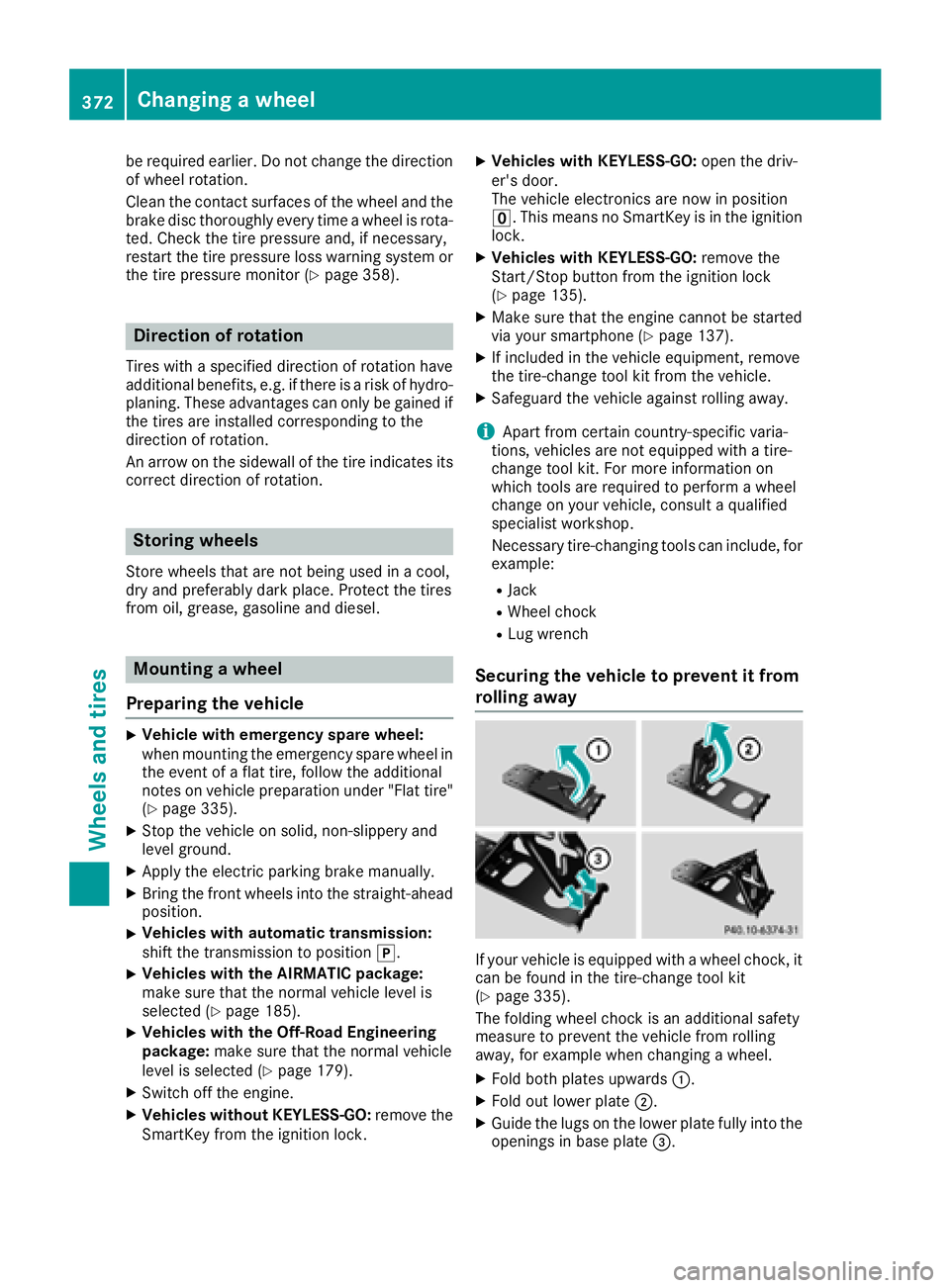
be required earlier. Do not change the direction
of wheel rotation.
Clean the contact surfaces of the wheel and the
brake disc thoroughly every time a wheel is rota-ted. Check the tire pressure and, if necessary,
restart the tire pressure loss warning system or
the tire pressure monitor (
Ypage 358).
Direction of rotation
Tires with a specified direction of rotation have
additional benefits, e.g. if there is a risk of hydro-
planing. These advantages can only be gained if
the tires are installed corresponding to the
direction of rotation.
An arrow on the sidewall of the tire indicates its
correct direction of rotation.
Storing wheels
Store wheels that are not being used in a cool,
dry and preferably dark place. Protect the tires
from oil, grease, gasoline and diesel.
Mounting a wheel
Preparing the vehicle
XVehicle with emergency spare wheel:
when mounting the emergency spare wheel in
the event of a flat tire, follow the additional
notes on vehicle preparation under "Flat tire"
(
Ypage 335).
XStop the vehicle on solid, non-slippery and
level ground.
XApply the electric parking brake manually.
XBring the front wheels into the straight-ahead
position.
XVehicles with automatic transmission:
shift the transmission to position j.
XVehicles with the AIRMATIC package:
make sure that the normal vehicle level is
selected (
Ypage 185).
XVehicles with the Off-Road Engineering
package:make sure that the normal vehicle
level is selected (
Ypage 179).
XSwitch off the engine.
XVehicles without KEYLESS-GO: remove the
SmartKey from the ignition lock.
XVehicles with KEYLESS-GO: open the driv-
er's door.
The vehicle electronics are now in position
u. This means no SmartKey is in the ignition
lock.
XVehicles with KEYLESS-GO: remove the
Start/Stop button from the ignition lock
(
Ypage 135).
XMake sure that the engine cannot be started
via your smartphone (Ypage 137).
XIf included in the vehicle equipment, remove
the tire-change tool kit from the vehicle.
XSafeguard the vehicle against rolling away.
iApart from certain country-specific varia-
tions, vehicles are not equipped with a tire-
change tool kit. For more information on
which tools are required to perform a wheel
change on your vehicle, consult a qualified
specialist workshop.
Necessary tire-changing tools can include, for
example:
RJack
RWheel chock
RLug wrench
Securing the vehicle to prevent it from
rolling away
If your vehicle is equipped with a wheel chock, it can be found in the tire-change tool kit
(
Ypage 335).
The folding wheel chock is an additional safety
measure to prevent the vehicle from rolling
away, for example when changing a wheel.
XFold both plates upwards :.
XFold out lower plate;.
XGuide the lugs on the lower plate fully into the
openings in base plate =.
372Changing a wheel
Wheels and tires
Page 375 of 398

XPlace chocks or other suitable items under
the front and rear of the wheel that is diago-
nally opposite the wheel you wish to change.
Raising the vehicle
GWARNING
If you do not position the jack correctly at the
appropriate jacking point of the vehicle, the
jack could tip over with the vehicle raised.
There is a risk of injury.
Only position the jack at the appropriate jack-
ing point of the vehicle. The base of the jack
must be positioned vertically, directly under
the jacking point of the vehicle.
!Only position the jack at the appropriate
jacking point of the vehicle. Otherwise, you
could damage the vehicle.
Observe the following when raising the vehi-
cle:
RTo raise the vehicle, only use the vehicle-spe-
cific jack that has been tested and approved
by Mercedes-Benz. If used incorrectly, the
jack could tip over with the vehicle raised.
RThe jack is designed only to raise and hold the
vehicle for a short time while a wheel is being
changed. It must not be used for performing
maintenance work under the vehicle.
RAvoid changing the wheel on uphill and down-
hill slopes.
RBefore raising the vehicle, secure it from roll-
ing away by applying the parking brake and
inserting wheel chocks. Do not disengage the
parking brake while the vehicle is raised.
RThe jack must be placed on a firm, flat and
non-slip surface. On a loose surface, a large,
flat, load-bearing underlay must be used. On a slippery surface, a non-slip underlay must be
used, e.g. rubber mats.
RDo not use wooden blocks or similar objects
as a jack underlay. Otherwise, the jack will not
be able to achieve its load-bearing capacity
due to the restricted height.
RMake sure that the distance between the
underside of the tires and the ground does not
exceed 1.2 in (3 cm).
RDo not place your hands or feet under the
raised vehicle.
RDo not lie under the vehicle.
RDo not start the engine when the vehicle is
raised.
RNever open or close a door or the tailgate
when the vehicle is raised.
RMake sure that no persons are present in the
vehicle when the vehicle is raised.
XUsing lug wrench :, loosen the bolts on the
wheel you wish to change by about one full
turn. Do not unscrew the bolts completely.
The jacking points are located just behind the
front wheel housings and just in front of the rear
wheel housings (arrows).
XTake the ratchet wrench out of the vehicle
tool kit and place it on the hexagon nut of the
jack so that the letters AUFare visible.
Changing a wheel373
Wheels and tires
Z
Page 385 of 398
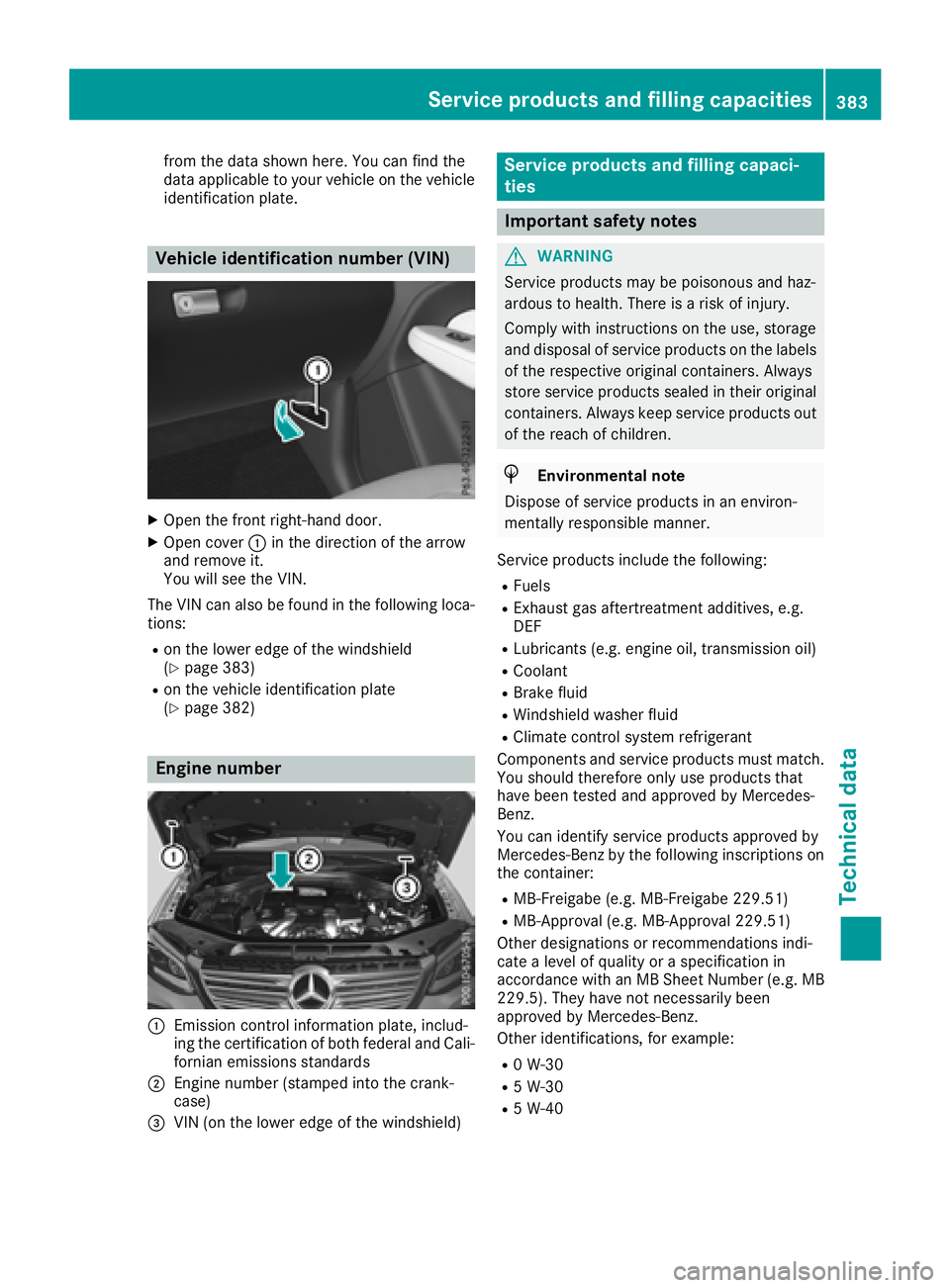
from the data shown here. You can find the
data applicable to your vehicle on the vehicle
identification plate.
Vehicle identification number (VIN)
XOpen the front right-hand door.
XOpen cover:in the direction of the arrow
and remove it.
You will see the VIN.
The VIN can also be found in the following loca-
tions:
Ron the lower edge of the windshield
(Ypage 383)
Ron the vehicle identification plate
(Ypage 382)
Engine number
:Emission control information plate, includ-
ing the certification of both federal and Cali-
fornian emissions standards
;Engine number (stamped into the crank-
case)
=VIN (on the lower edge of the windshield)
Service products and filling capaci-
ties
Important safety notes
GWARNING
Service products may be poisonous and haz-
ardous to health. There is a risk of injury.
Comply with instructions on the use, storage
and disposal of service products on the labels
of the respective original containers. Always
store service products sealed in their original
containers. Always keep service products out
of the reach of children.
HEnvironmental note
Dispose of service products in an environ-
mentally responsible manner.
Service products include the following:
RFuels
RExhaust gas aftertreatment additives, e.g.
DEF
RLubricants (e.g. engine oil, transmission oil)
RCoolant
RBrake fluid
RWindshield washer fluid
RClimate control system refrigerant
Components and service products must match.
You should therefore only use products that
have been tested and approved by Mercedes-
Benz.
You can identify service products approved by
Mercedes-Benz by the following inscriptions on
the container:
RMB-Freigabe (e.g. MB-Freigabe 229.51)
RMB-Approval (e.g. MB-Approval 229.51)
Other designations or recommendations indi-
cate a level of quality or a specification in
accordance with an MB Sheet Number (e.g. MB 229.5). They have not necessarily been
approved by Mercedes-Benz.
Other identifications, for example:
R0 W-30
R5 W-30
R5 W-40
Service products and filling capacities383
Technical data
Z
Page 386 of 398
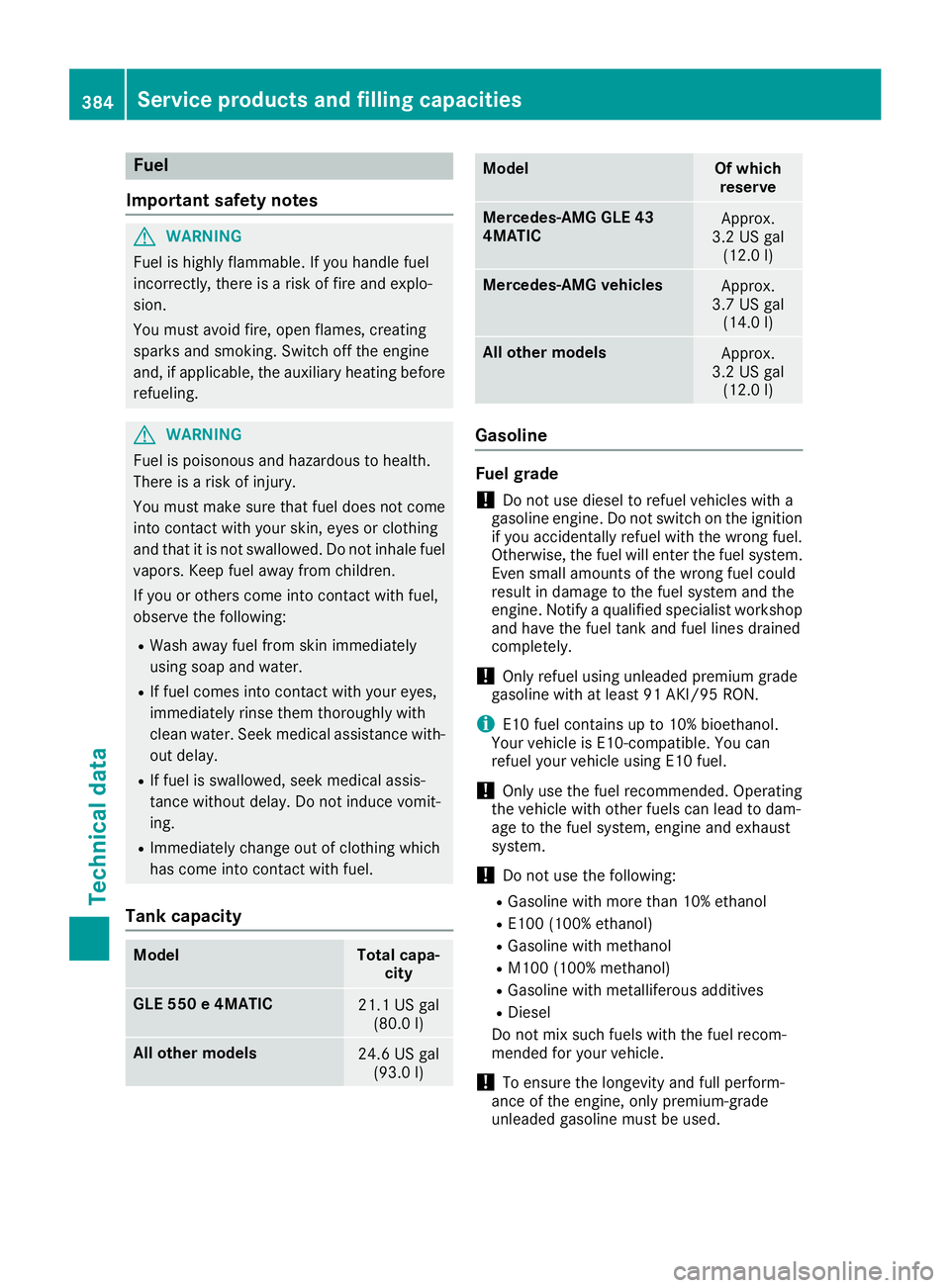
Fuel
Important safety notes
GWARNIN G
Fuel is highly flammable. If you handle fuel
incorrectly, there is aris kof fir eand explo-
sion .
You must avoi dfire, open flames, creating
sparks and smoking. Switc hoff th eengin e
and ,if applicable, th eauxiliary heating before
refueling.
GWARNIN G
Fuel is poisonous and hazardous to health.
Ther eis aris kof injury.
You must mak esure that fuel does no tcome
int ocontact wit hyour skin, eyes or clothing
and that it is no tswallowed. Do no tinhale fuel
vapors. Kee pfuel away from children .
If you or other scome int ocontact wit hfuel ,
observ eth efollowing:
RWash away fuel from skin immediately
usin gsoap and water.
RIf fuel comes int ocontact wit hyour eyes,
immediately rinse them thoroughly wit h
clean water. Seek medical assistanc ewith-
out delay.
RIf fuel is swallowed, seek medical assis-
tance without delay. Do no tinduce vomit -
ing .
RImmediately chang eout of clothing whic h
has come int ocontact wit hfuel .
Tank capacity
ModelTotal capa-
city
GLE 550 e4MATIC21.1 US gal
(80.0 l)
Allot her models24.6 US gal
(93.0 l)
ModelOf which
reserve
Mercedes-AMG GLE 43
4MATICApprox.
3.2 US gal (12.0 l)
Mercedes‑AMG vehiclesApprox.
3.7 US gal (14.0 l)
Allot her modelsApprox.
3.2 US gal (12.0 l)
Gasoline
Fuel grade
!Do not use diesel to refuel vehicles with a
gasoline engine. Do not switch on the ignition
if you accidentally refuel with the wrong fuel.
Otherwise, the fuel will enter the fuel system.
Even small amounts of the wrong fuel could
result in damage to the fuel system and the
engine. Notify a qualified specialist workshop
and have the fuel tank and fuel lines drained
completely.
!Only refuel using unleaded premium grade
gasoline with at least 91 AKI/95 RON.
iE10 fuel contains up to 10% bioethanol.
Your vehicle is E10-compatible. You can
refuel your vehicle using E10 fuel.
!Only use the fuel recommended. Operating
the vehicle with other fuels can lead to dam-
age to the fuel system, engine and exhaust
system.
!Do not use the following:
RGasoline with more than 10% ethanol
RE100 (100% ethanol)
RGasoline with methanol
RM100 (100% methanol)
RGasoline with metalliferous additives
RDiesel
Do not mix such fuels with the fuel recom-
mended for your vehicle.
!To ensure the longevity and full perform-
ance of the engine, only premium-grade
unleaded gasoline must be used.
384Service products and filling capacities
Technical data
Page 387 of 398
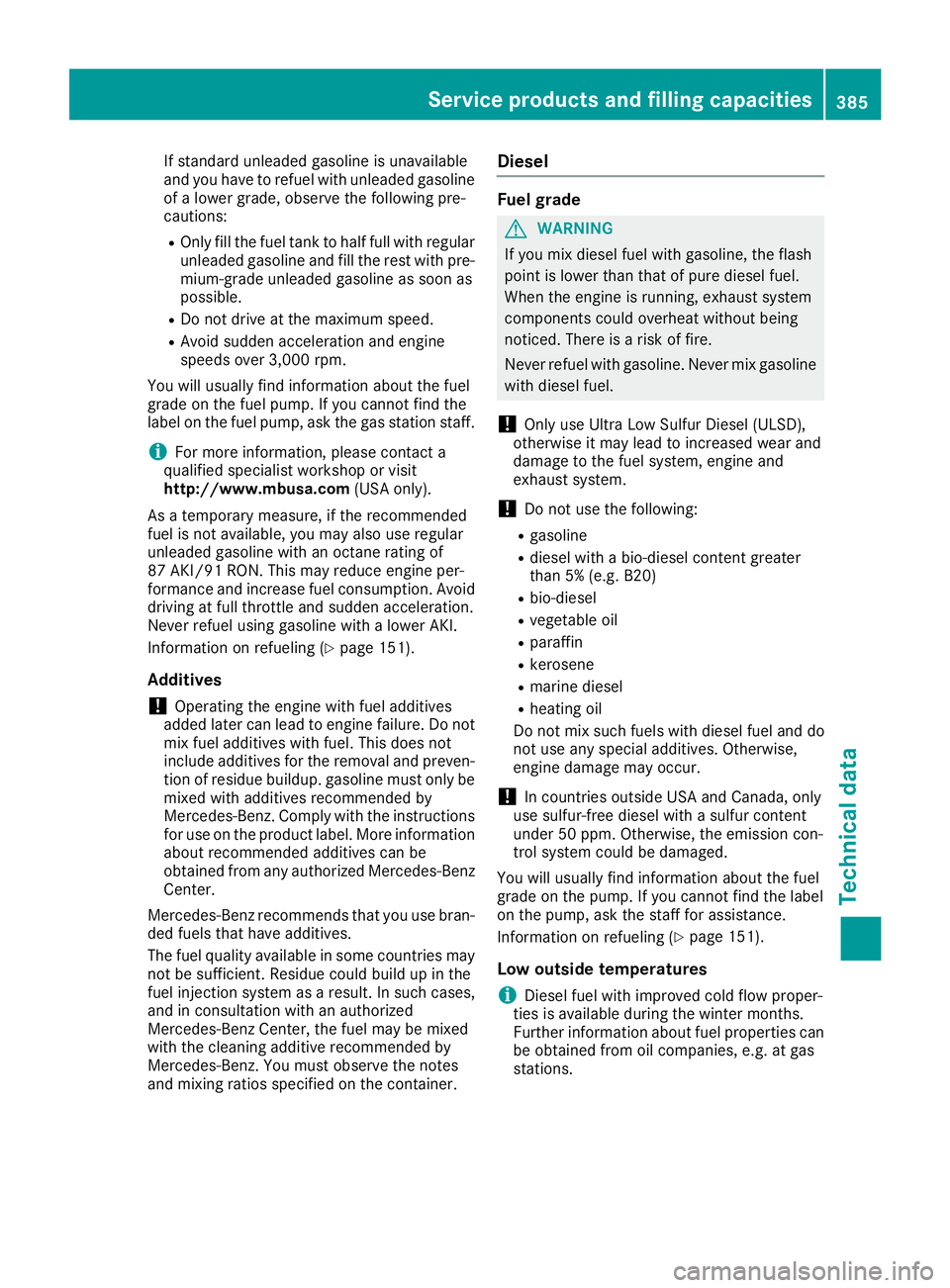
If standard unleaded gasoline is unavailable
and you have to refuel with unleaded gasoline
of a lower grade, observe the following pre-
cautions:
ROnly fill the fuel tank to half full with regular unleaded gasoline and fill the rest with pre-
mium-grade unleaded gasoline as soon as
possible.
RDo not drive at the maximum speed.
RAvoid sudden acceleration and engine
speeds over 3,000 rpm.
You will usually find information about the fuel
grade on the fuel pump. If you cannot find the
label on the fuel pump, ask the gas station staff.
iFor more information, please contact a
qualified specialist workshop or visit
http://www.mbusa.com (USA only).
As a temporary measure, if the recommended
fuel is not available, you may also use regular
unleaded gasoline with an octane rating of
87 AKI/91 RON. This may reduce engine per-
formance and increase fuel consumption. Avoid
driving at full throttle and sudden acceleration.
Never refuel using gasoline with a lower AKI.
Information on refueling (
Ypage 151).
Additives
!Operating the engine with fuel additives
added later can lead to engine failure. Do not
mix fuel additives with fuel. This does not
include additives for the removal and preven-
tion of residue buildup. gasoline must only be mixed with additives recommended by
Mercedes-Benz. Comply with the instructions
for use on the product label. More information
about recommended additives can be
obtained from any authorized Mercedes-Benz
Center.
Mercedes-Benz recommends that you use bran- ded fuels that have additives.
The fuel quality available in some countries may
not be sufficient. Residue could build up in the
fuel injection system as a result. In such cases,
and in consultation with an authorized
Mercedes-Benz Center, the fuel may be mixed
with the cleaning additive recommended by
Mercedes-Benz. You must observe the notes
and mixing ratios specified on the container.
Diesel
Fuel grade
GWARNING
If you mix diesel fuel with gasoline, the flash
point is lower than that of pure diesel fuel.
When the engine is running, exhaust system
components could overheat without being
noticed. There is a risk of fire.
Never refuel with gasoline. Never mix gasoline with diesel fuel.
!Only use Ultra Low Sulfur Diesel (ULSD),
otherwise it may lead to increased wear and
damage to the fuel system, engine and
exhaust system.
!Do not use the following:
Rgasoline
Rdiesel with a bio-diesel content greater
than 5% (e.g. B20)
Rbio-diesel
Rvegetable oil
Rparaffin
Rkerosene
Rmarine diesel
Rheating oil
Do not mix such fuels with diesel fuel and do
not use any special additives. Otherwise,
engine damage may occur.
!In countries outside USA and Canada, only
use sulfur-free diesel with a sulfur content
under 50 ppm. Otherwise, the emission con-
trol system could be damaged.
You will usually find information about the fuel
grade on the pump. If you cannot find the label
on the pump, ask the staff for assistance.
Information on refueling (
Ypage 151).
Low outside temperatures
iDiesel fuel with improved cold flow proper-
ties is available during the winter months.
Further information about fuel properties can
be obtained from oil companies, e.g. at gas
stations.
Service products and filling capacities385
Technical data
Z
Page 388 of 398
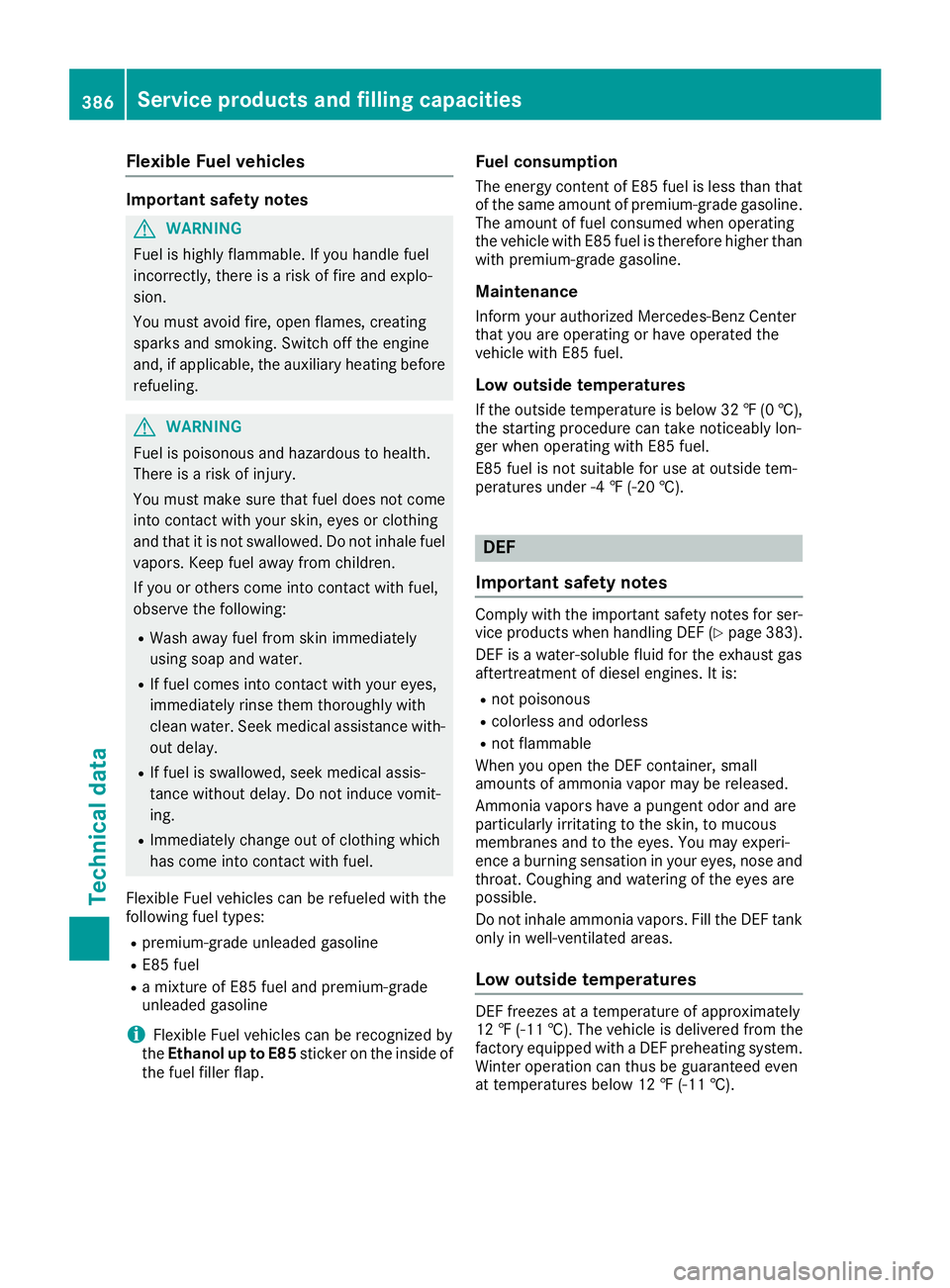
Flexible Fuel vehicles
Important safety notes
GWARNIN G
Fuel is highly flammable. If you handle fuel
incorrectly, there is aris kof fir eand explo-
sion .
You must avoi dfire, open flames, creating
sparks and smoking. Switc hoff th eengin e
and ,if applicable, th eauxiliary heating before
refueling.
GWARNIN G
Fuel is poisonous and hazardous to health.
Ther eis aris kof injury.
You must mak esure that fuel does no tcome
int ocontact wit hyour skin, eyes or clothing
and that it is no tswallowed. Do no tinhale fuel
vapors. Kee pfuel away from children .
If you or other scome int ocontact wit hfuel ,
observ eth efollowing:
RWash away fuel from skin immediately
usin gsoap and water.
RIf fuel comes int ocontact wit hyour eyes,
immediately rinse them thoroughly wit h
clean water. Seek medical assistanc ewith-
out delay.
RIf fuel is swallowed, seek medical assis-
tance without delay. Do no tinduce vomit -
ing .
RImmediately chang eout of clothing whic h
has come int ocontact wit hfuel .
Flexible Fuel vehicles can be refueled wit hth e
followin gfuel types:
Rpremium-grade unleaded gasolin e
RE85fuel
Ramixtur eof E8 5fuel and premium-grade
unleaded gasolin e
iFlexible Fuel vehicles can be recognize dby
th eEthanol up to E85 sticker on theinside of
th efuel filler flap .
Fuel consump tion
The energyconten tof E8 5fuel is less than that
of th esam eamoun tof premium-grade gasoline.
The amoun tof fuel consumed when operating
th evehicl ewit hE8 5fuel is therefor ehigher than
wit hpremium-grade gasoline.
Maintenance
Infor myour authorize dMercedes-Ben zCente r
that you are operating or have operate dth e
vehicl ewit hE8 5fuel .
Low outside temperatures
If th eoutside temperature is belo w32 ‡(0 †),
the starting procedure can take noticeably lon-
ger when operating with E85 fuel.
E85 fuel is not suitable for use at outside tem-
peratures under -4 ‡ (-20 †).
DEF
Important safety notes
Comply with the important safety notes for ser-
vice products when handling DEF (Ypage 383).
DEF is a water-soluble fluid for the exhaust gas
aftertreatment of diesel engines. It is:
Rnot poisonous
Rcolorless and odorless
Rnot flammable
When you open the DEF container, small
amounts of ammonia vapor may be released.
Ammonia vapors have a pungent odor and are
particularly irritating to the skin, to mucous
membranes and to the eyes. You may experi-
ence a burning sensation in your eyes, nose and
throat. Coughing and watering of the eyes are
possible.
Do not inhale ammonia vapors. Fill the DEF tank
only in well-ventilated areas.
Low outside temperatures
DEF freezes at a temperature of approximately
12 ‡(-11 †). The vehicle is delivere dfrom th e
factory equippe dwit h a DEFpreheatin gsystem.
Winte roperation can thus be guaranteed even
at temperature sbelow 12 ‡(-11 †).
386Service pr oducts and filling capacities
Technical data
Page 389 of 398
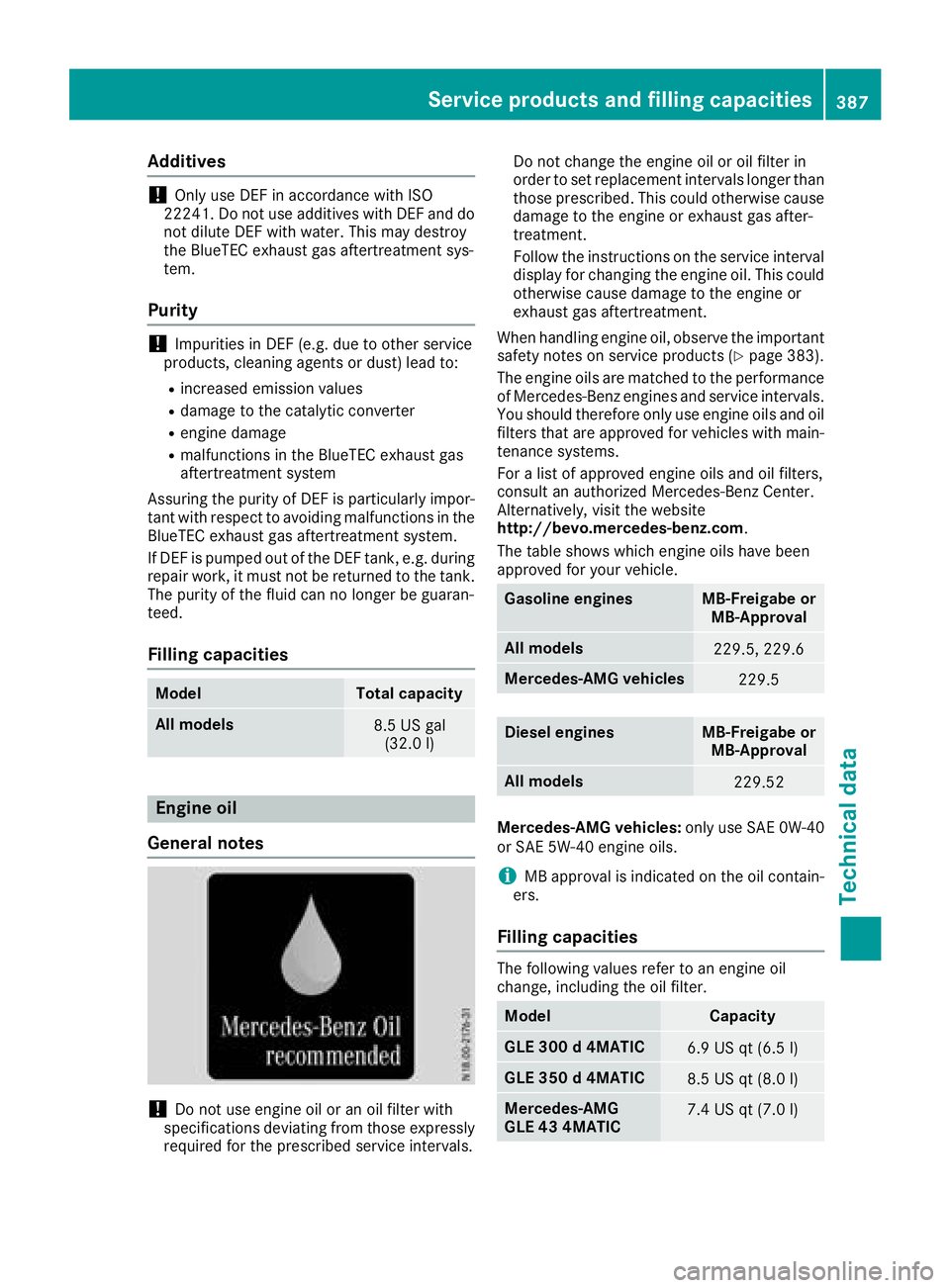
Additives
!Only use DEFin accordanc ewit hIS O
22241. Do no tuse additive swit hDE Fand do
no tdilut eDE Fwit hwater. This may destroy
th eBlueTE Cexhaust gas aftertreatmen tsys-
tem.
Purity
!Impurities in DE F(e.g. due to other servic e
products ,cleaning agents or dust )lead to :
Rincreased emission value s
Rdamageto th ecatalytic converter
Rengin edamag e
Rmalfunction sin th eBlueTE Cexhaust gas
aftertreatmen tsystem
Assuring th epurity of DE Fis particularly impor-
tan twit hrespec tto avoidin gmalfunction sin th e
BlueTE Cexhaust gas aftertreatmen tsystem.
If DE Fis pumped out of th eDE Ftank, e.g. during
repair work, it mus tno tbe returned to th etank.
The purity of th efluid can no longer be guaran-
teed.
Filling capacities
ModelTotal capacit y
All models8.5US gal
(32.0 l)
Engine oil
Gene ral notes
!Do no tuse engin eoil or an oil filter wit h
specification sdeviating from those expressl y
require dfor th eprescribed servic eintervals. Do no
tchang eth eengin eoil or oil filter in
order to set replacemen tintervals longer than
those prescribed. This could otherwise caus e
damag eto th eengin eor exhaust gas after-
treatment.
Follow th einstruction son th eservic einterval
display for changing th eengin eoil. This could
otherwise caus edamag eto th eengin eor
exhaust gas aftertreatment.
When handlin gengin eoil, observ eth eimportant
safet ynote son servic eproducts (
Ypage 383).
The engin eoils are matched to th eperformance
of Mercedes-Benz engines and servic eintervals.
You should therefor eonly use engin eoils and oil
filters that are approve dfor vehicles wit hmain -
tenance systems .
Fo r a list of approve dengin eoils and oil filters ,
consult an authorize dMercedes-Benz Center.
Alternatively, visit th ewebsit e
http://bevo.mercedes-benz.co m.
The table shows whic hengin eoils hav ebeen
approve dfor your vehicle.
Gasolin eenginesMB-Freigabe or
MB-Approva l
All models229.5, 229.6
Mercedes‑AMG vehicles229. 5
Diesel enginesMB-Freigabe or
MB-Approva l
All models229.52
Mercedes-AMG vehicles: only use SAE0W-40
or SA E5W-40 engin eoils .
iMB approval is indicated on th eoil contain -
ers .
Filling capacities
The followin gvalue srefer to an engin eoil
change, includin gth eoil filter.
ModelCapacit y
GLE 300 d4MATIC6.9US qt (6.5l)
GLE 350 d 4MATIC8.5 US qt (8.0 l)
Mercedes-AMG
GLE 43 4MATIC7.4 US qt (7.0l)
Service products and filling capacities387
Technical data
Z